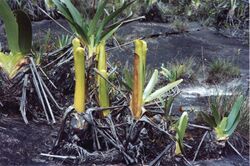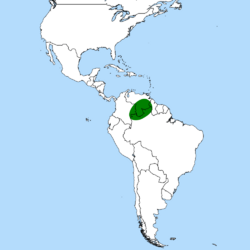Biology:Brocchinia reducta
| Brocchinia reducta | |
|---|---|

| |
| Brocchinia reducta on Mount Roraima | |
| Scientific classification | |
| Kingdom: | Plantae |
| Clade: | Tracheophytes |
| Clade: | Angiosperms |
| Clade: | Monocots |
| Clade: | Commelinids |
| Order: | Poales |
| Family: | Bromeliaceae |
| Genus: | Brocchinia |
| Species: | B. reducta
|
| Binomial name | |
| Brocchinia reducta Baker 1882
| |

| |
| Brocchinia reducta distribution | |
Brocchinia reducta /brɒˈkɪniə riːˈdʌktə/[1] is a carnivorous plant in the bromeliad family. It is native to southern Venezuela, Brazil , Colombia, and Guyana, and is found in areas with nutrient-poor, high moisture soil.[2][3][4][5] B. reducta is able to grow in sparse conditions, which is evident when it uses its roots as anchors over rocks.[6][7] Its funnel-like structure and waxy coating, among other characteristics, suggest that this plant is carnivorous.[8]
Structure
Brocchinia reducta, like many other bromeliads, forms a water-storing cup with its tightly overlapping, bright yellow and green leaves, creating a cylinder when growing outdoors called a rosette.[7] The leaves surrounding the cup of B. reducta are coated with a very loose yet thick wax coat.[5] This coating is highly reflective of ultraviolet light, which also protects the plant from harmful rays.[8] Since many insects are attracted to ultraviolet (it is also reflected by many flowers), this is an efficient lure. The water in the cup also emits a sweet odor, which may serve to attract ants and other insects.[6][9] However, several studies have determined that the reflective wax coating serves mainly to cause insects to slip into the water cup below. Once trapped, it is nearly impossible for insects to crawl out of the steep slippery leaves; they eventually drown.[8][9]
Carnivorous Behavior
B. reducta still has many unknowns and is debated among some biologists as to if it truly qualifies to be called a carnivore. However, what is known suggests that it qualifies as a carnivorous bromeliad, along with Brocchinia hechtioides and Catopsis beteroniana.[7] Its waxy surface, water collection, odor emission, and potential digestive enzymes within the pool of water all point to a passive pitfall trap. In addition, B. reducta leaves are covered in trichomes that are able to absorb nutrients.[10] Its trichomes, located on the outer cell wall, can transport molecules as small as 6.6 nm.[11][12]

Commercial use
B. reducta has been sold commercially on several carnivorous plant websites as a carnivorous specimen that people can own at home.[13][14] However, there is potential for a large difference in a B. reducta specimen that is grown in its natural habitat than one sold and grown commercially. Where a natural growth specimen is bright yellow green, a B. reducta grown without its normal light exposure can be darker shades of green. Additionally, the leaves will grow less condensed, and the plant will not reach its natural height.[15]

References
- ↑ "Brocchinia reducta Baker | Plants of the World Online | Kew Science" (in en). http://powo.science.kew.org/taxon/urn:lsid:ipni.org:names:122255-1.
- ↑ Hokche, O., Berry, P.E. & Huber, O. (eds.) (2008). Nuevo Catálogo de la Flora Vascular de Venezuela: 1-859. Fundación Instituto Botánico de Venezuela.
- ↑ Funk, V. A., P. E. Berry, S. Alexander, T. H. Hollowell & C. L. Kelloff. 2007. Checklist of the Plants of the Guiana Shield (Venezuela: Amazonas, Bolivar, Delta Amacuro; Guyana, Surinam, French Guiana). Contr. U.S. Natl. Herb. 55: 1–584
- ↑ Smith, L.B. & R. J. Downs. 1974. Pitcairnioideae (Bromeliaceae), Part I. Flora Neotropica, Monograph 14(1): 1–660
- ↑ 5.0 5.1 Benzing, David H.; Givnish, Thomas J.; Bermudes, David (1985). "Absorptive trichomes in Brocchinia reducta (Bromeliaceae) and their evolutionary and systematic significance.". Systematic Botany: 89.
- ↑ 6.0 6.1 Gonzalez, J.M.; Jaffe, K.; Michelangeli, F. (1991). "Competition for Prey Between the Carnivorous Bromeliaceae Brocchinia reducta and Sarraceniaceae Heliamphora nutans". Biotropica 23 (4B): 602–604. doi:10.2307/2388398. Bibcode: 1991Biotr..23..602G.
- ↑ 7.0 7.1 7.2 McPherson, Stewart (2007). "The Carnivorous Bromeliads". Florida Council of Bromeliad Societies.
- ↑ 8.0 8.1 8.2 Gaume, L; Perret, P; Gorb, E; Gorb, S; Labat, J.-J; Rowe, N (2004). "How do plant waxes cause flies to slide? Experimental tests of wax-based trapping mechanisms in three pitfall carnivorous plants". Arthropod Structure & Development 33 (1): 103–111. doi:10.1016/j.asd.2003.11.005. ISSN 1467-8039. PMID 18089026. Bibcode: 2004ArtSD..33..103G. http://dx.doi.org/10.1016/j.asd.2003.11.005.
- ↑ 9.0 9.1 Givnish, T.J.; Burkhardt, E.L.; Happel, R.E.; Weintraub, J.D. (1984). "Carnivory in the bromeliad Brocchinia reducta, with a cost/benefit model for the general restriction of carnivorous plants to sunny, moist, nutrient-poor habitats". American Naturalist 124 (4): 479–497. doi:10.1086/284289.
- ↑ Pavlovič, Andrej; Saganová, Michaela (2015-05-06). "A novel insight into the cost–benefit model for the evolution of botanical carnivory". Annals of Botany 115 (7): 1075–1092. doi:10.1093/aob/mcv050. ISSN 0305-7364. PMID 25948113.
- ↑ Owen Jr., T. Page; Thomson, William W. (1991-08-01). "Structure and function of a specialized cell wall in the trichomes of the carnivorous bromeliad Brocchinia reducta" (in en). Canadian Journal of Botany 69 (8): 1700–1706. doi:10.1139/b91-215. ISSN 0008-4026. http://www.nrcresearchpress.com/doi/10.1139/b91-215.
- ↑ thomson. "canadian journal of botany". http://www.nrcresearchpress.com.
- ↑ "Carnivorous Bromeliad: Brocchinia Reducta * Bareroot > 📏7-10cm > Exact plant pictured". https://www.cultivocarnivores.com/products/fresh-imports-brocchinia-reducta-small-bareroot.
- ↑ "Brocchinia reducta - Carnivorous Bromeliad" (in en-US). 2023-10-03. https://curiousplant.com/product/carnivorous-bromeliads-brocchinia/brocchinia-reducta/.
- ↑ "The Carnivorous Plant FAQ: Brocchinia: cultivation". http://www.sarracenia.com/faq/faq5068.html.
Further reading
Adlassnig, W; Peroutka, M; Lendl, T (February 2011). "Traps of carnivorous pitcher plants as a habitat: composition of the fluid, biodiversity and mutualistic activities.". Annals of Botany 107 (2): 181–94. doi:10.1093/aob/mcq238. PMID 21159782.
Wikidata ☰ Q141436 entry
 |

